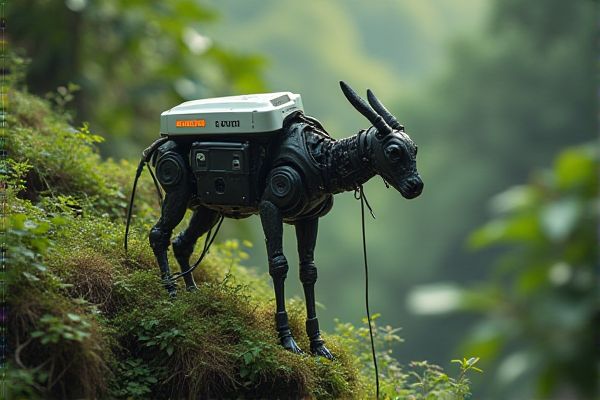
AI plays a crucial role in ecological conservation by analyzing vast amounts of environmental data to identify patterns and trends. Machine learning algorithms can predict species behavior, helping conservationists focus efforts on at-risk populations. Drones equipped with AI technology monitor ecosystems and wildlife habitats, providing real-time data to assess health and threats. Furthermore, AI-driven tools streamline resource allocation, ensuring that conservation initiatives are both effective and efficient in preserving biodiversity.
AI usage in ecological conservation
Habitat Monitoring
AI can enhance ecological conservation efforts by improving habitat monitoring through advanced data analysis. For instance, machine learning algorithms can analyze satellite imagery to assess changes in forest cover, enabling timely interventions. This technology allows conservationists to predict potential threats to ecosystems, enhancing their response strategies. Organizations like the World Wildlife Fund are increasingly adopting AI for more effective habitat management and preservation.
Species Identification
AI can significantly enhance species identification by analyzing vast amounts of data from images and sounds captured in natural habitats. Advanced algorithms, like those implemented by institutions such as the Cornell Lab of Ornithology, enable accurate classification of bird species based on audio recordings. This technology increases the likelihood of detecting rare species, thereby aiding in conservation efforts. As more data becomes available, the potential for AI to assist in biodiversity monitoring and assessment expands.
Poaching Prevention
AI technology shows promise in ecological conservation, particularly in poaching prevention. By analyzing patterns and behaviors, AI can predict poaching activities, enabling quicker interventions by conservation authorities. For example, organizations like Wildlife Conservation Society leverage AI to monitor wildlife populations and enhance anti-poaching strategies. This approach increases the chances of protecting endangered species and maintaining biodiversity.
Climate Impact Analysis
AI technologies have the potential to analyze vast amounts of ecological data, leading to improved climate impact assessments. For instance, the application of machine learning algorithms can enhance predictions of species' responses to climate change. Organizations like the World Wildlife Fund are increasingly leveraging AI to monitor wildlife populations and habitats effectively. This integration could provide significant advantages in formulating strategies for conservation efforts and policy-making.
Biodiversity Tracking
AI can enhance ecological conservation by improving biodiversity tracking through advanced data analysis. By using machine learning algorithms, researchers can identify and monitor species populations more accurately, leading to better-informed conservation strategies. For example, tools developed by institutions like the Nature Conservancy can analyze vast amounts of environmental data to detect changes in habitats. This approach increases the chances of effective interventions to preserve endangered species and ecosystems.
Reforestation Planning
AI technology can analyze satellite imagery to identify deforested areas, streamlining reforestation planning efforts. Such analytics can improve the selection of tree species suited for specific climates, enhancing survival rates. Organizations like the World Wildlife Fund utilize similar methodologies to maximize the impact of their conservation initiatives. With these advanced tools, the chances of successful restoration projects can significantly increase.
Environmental Policy Modeling
AI has the potential to enhance ecological conservation efforts through advanced data analysis and predictive modeling. For instance, environmental policy modeling can leverage AI to identify the most effective strategies for biodiversity preservation in regions such as the Amazon rainforest. Accurate predictions about environmental changes can inform policies that aim to mitigate adverse impacts on ecosystems. This technology may also help optimize resource allocation, improving the overall efficacy of conservation initiatives.
Wildlife Migration Patterns
AI can analyze vast amounts of data to identify wildlife migration patterns, providing insights for conservation efforts. By employing machine learning algorithms, organizations like the World Wildlife Fund can predict changes in animal movements due to climate change. Accurate predictions can lead to more effective conservation strategies and the protection of endangered species. The potential for AI to enhance our understanding of ecological dynamics presents significant advantages for preserving biodiversity.
Ecosystem Health Assessment
AI can enhance ecological conservation by providing data-driven insights into ecosystem health. For example, the use of machine learning algorithms can optimize the assessment of biodiversity in protected areas, potentially improving species population monitoring. This technology might also predict the impacts of climate change on various habitats, allowing for more effective management strategies. The integration of AI tools in institutions like environmental research organizations could lead to more efficient resource allocation and better conservation outcomes.
Water Resource Management
AI can enhance ecological conservation by analyzing large datasets to identify patterns in wildlife behavior and habitat changes. For instance, organizations like the World Wildlife Fund utilize AI algorithms to monitor endangered species and predict their migration paths. In water resource management, AI models can optimize irrigation schedules, ensuring efficient usage of water, which could potentially increase crop yield. This integration of AI can lead to improved decision-making, ultimately benefiting both environmental sustainability and agricultural productivity.
 techknowy.com
techknowy.com